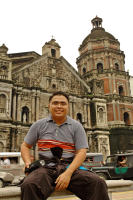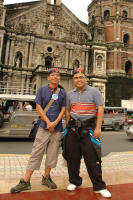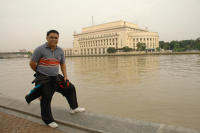 When we hear the word Taal, the first thing that comes to mind is the volcano, a classic image of the Philippine Islands, one viewed from the hills of Tagaytay City. What we rarely notice though is Taal, the heritage town, one steeped in history and heritage!
When we hear the word Taal, the first thing that comes to mind is the volcano, a classic image of the Philippine Islands, one viewed from the hills of Tagaytay City. What we rarely notice though is Taal, the heritage town, one steeped in history and heritage!I've been to Taal several times but the town never fails to call me back. Maybe it's because of the quaint feel of centuries-old houses that line-up along the narrow streets of this former capital of Batangas province, the magnificent Taal Basilica or the miraculous image of the Virgin of Caysasay housed in a shrine close to a well with healing waters. Or maybe it is the elaborately embroidered piña cloth which I use for my barongs. And piña cloth did I bring home that day. Aside from the panotcha, bokayo, macapuno and kalamay of course!
I was invited by architecture students from Adamson University to join them on their tour. Jeremy, the president of the UAPSA Adamson Chapter, wanted me to give a word or two on heritage conservation in the hope that his fellow students would be encouraged to start a chapter in their school.
We arrived in Taal at about 10 a.m. just in time for a morning snack served by our host, Dindo Agoncillo, a man at the forefront of the heritage advocacy in Taal. What I have been in San Fernando for the past five years, Dindo had been in Taal for more than a decade. We stayed for a while at the Escuela Pia, one of the seven National Historical Landmarks in Taal! As Dindo mentions, Taal holds the record for having the most number of National Historical Landmarks declared by the NHI.
Anyway, it was empanada again... hehehe! But it was unusual since the filling was sotanghon!
After snacks, we went to the Municipal Hall, another National Historical Landmark, for a brief introduction on Taal and efforts to preserve it. This was followed by a walk around Taal, but I left the group for a while since the market called as always. I wanted to get my piña cloth early since I saw we didn't have time to do it in the afternoon given the jampacked itinerary Dindo had prepared.
 I met up with the group again at the Basilica of St. Martin of Tours, another National Historical Landmark, and reputably, the biggest church in Asia. The church was first built by Father Diego Espina in 1575 in San Nicolas. It was destroyed when Taal volcano erupted in 1754. In 1755, it was rebuilt at the present site but was destroyed again by an earthquake in 1849. Construction of the present church begun in 1856 supervised by architect Lucina Oliver.
I met up with the group again at the Basilica of St. Martin of Tours, another National Historical Landmark, and reputably, the biggest church in Asia. The church was first built by Father Diego Espina in 1575 in San Nicolas. It was destroyed when Taal volcano erupted in 1754. In 1755, it was rebuilt at the present site but was destroyed again by an earthquake in 1849. Construction of the present church begun in 1856 supervised by architect Lucina Oliver.Lunch was served at one of the Gabaldon school buildings. And a feast it was with the local flavors served buffet!
The afternoon begun with a walk along another of the heritage streets where restoration on several houses was ongoing. Of course, you could see that some were being done right since they had the right consultants. And others... oh brother! The results of the whims and caprices of their owners and their wrong notions of restoration, these abominations were an outright waste of good money. Sad to see houses rotting as well. That's the problem, we still have a few places with high concentrations of built heritage but no funds to restore everything. So they usually end up in antique or junk shops... sigh!
 We went down the San Lorenzo staircase that led to the Caysasay Shrine. Lucky for us, the original image was there (the one in the altar is just a replica). Of course, the group of 160 students crowded around it. So I waited for everyone to leave for the well to get the traditional blessing from the image. This entails kneeling down while the image is placed on your head. Then you make your wish!
We went down the San Lorenzo staircase that led to the Caysasay Shrine. Lucky for us, the original image was there (the one in the altar is just a replica). Of course, the group of 160 students crowded around it. So I waited for everyone to leave for the well to get the traditional blessing from the image. This entails kneeling down while the image is placed on your head. Then you make your wish!That accomplished, it was off to the well and its healing waters.
The last two stops for the day were two other National Historical Landmarks, the homes of Marcela Agoncillo, who is most known for sewing the original Philippine flag, and Leon Apacible, one of the delegates to the Malolos Congress.
All that walking got me real tired. So I just had to take a trike back to the bus. Pant! Pant!






